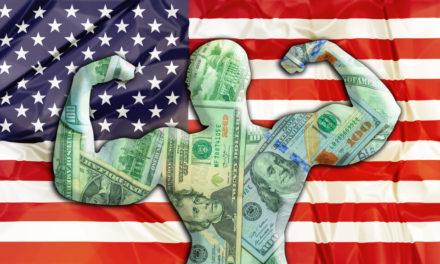The U.S. economy is showing consistent strength even after nearly a decade of growth, with Friday’s jobs report for August signaling that employers remain optimistic enough to hire freely and are finally paying more generously.
Consumers, the principal drivers of growth, are more confident than they’ve been in nearly 18 years. Americans are splurging on restaurant meals, clothes and cars.
Still, potential problems loom: The Trump administration is ramping up its trade fights, and interest rates appear likely to keep rising. The result is that businesses and consumers will likely find it somewhat more expensive to spend and borrow.
For now, though, the economy is expanding steadily, fueled by tax cuts, confident consumers, greater business investment in equipment and more government spending. Economic growth reached 4.2 percent at an annual rate in the April-June quarter, the fastest pace in four years.
Here are some key vital signs of the U.S. economy, roughly two months before the November midterm elections, which could transform the balance of power in Congress and reshape the economy:
HIRING IS BOOMING
U.S. employers added a robust 201,000 jobs in August, the Labor Department said Friday, in line with the past year’s average monthly gain of 196,000. The unemployment rate remains at an ultra-low 3.9 percent, a rate that most economists say could fall even further if the pace of hiring remains vigorous.
Mark Zandi, chief economist at Moody’s Analytics, forecasts that the jobless rate could reach 3.5 percent or even lower by next year. That would be the lowest level in roughly 50 years.
Other measures of the job market are also brightening. Companies are asking their part-time workers, for example, to work more hours, which has the effect of increasing their weekly pay.
The number of part-time workers who would prefer full-time work fell in August and is now at its lowest level since the Great Recession ended more than nine years ago.
A broader measure of unemployment, which includes those involuntary part-timers as well as discouraged workers who are no longer seeking jobs, dropped to 7.4 percent last month, the lowest level in 17 years.
BUT TRADE FIGHTS LOOM
On Friday, President Donald Trump ramped up his trade war with China by threatening to impose tariffs on an additional $267 billion in Chinese imports. That is on top of previous threats the president has made to slap tariffs on $200 billion of Chinese goods. The administration has already imposed 25 percent taxes on $50 billion of Chinese imports, a step for which Beijing retaliated against U.S. exports.
If all the threatened U.S. tariffs were imposed, they would cover everything the U.S. buys from China — from toys to handbags to smartphones.
Zandi estimates that if just the new tariffs on $200 billion in goods were put in place, U.S. economic growth would slow by a quarter-percentage point over the following year — and roughly 400,000 fewer jobs would be created.
WAGES ARE RISING
For many economists, the brightest spot in the August jobs report was that average hourly pay rose 2.9 percent compared with a year ago, the healthiest such increase in nine years.
As the job market has tightened and unemployment has dropped, businesses have complained that they can’t find enough qualified workers to fill all their open jobs. Some economists note that if employers offered more generous pay, they would attract more job candidates, including people who aren’t now looking for work and therefore aren’t counted as unemployed.
Friday’s jobs report, with its evidence of faster wage growth, suggested that some employers might finally be ramping up pay. Larger paychecks would underpin healthy consumer spending in the months ahead.
“It looks like we’re finally seeing that acceleration in wage growth that we’ve been waiting for,” said Gus Faucher, chief economist at PNC Financial Services. “It’s good news for workers’ paychecks, it’s good news for consumers and it’s good news for the overall economy.”
Jason Mazzarone, chief executive of SoBol, a restaurant chain that sells a variety of acai bowls, says he’s paying his employees more, mostly because of higher minimum wage laws in New York and other states where his 26-store chain operates. He has also raised pay for other workers who were already earning more than the minimum.
On New York’s Long Island, for example, where many of his outlets are located, the minimum wage will reach $12 an hour by year’s end. For shift managers now making $16 an hour, Mazzarone said, “their pay has to go up too.”
BUT BORROWING COSTS ARE UP, TOO
Solid hiring and greater wage growth, though, have made it a near-certainty that the Federal Reserve will raise short-term interest rates when it meets later this month. Most Fed watchers also expect another rate hike in December and perhaps three more next year.
Those rate increases are intended to prevent the economy from overheating and control inflation, which reached 2.9 percent in July — above the Fed’s 2 percent target level. The Fed’s benchmark rate is between 1.75 percent and 2 percent, still very low by historical standards.
But higher borrowing rates tend to squeeze consumers and businesses, weaken home buying, undercut stock prices and eventually slow growth. At some point, Fed policymakers might inadvertently raise rates high enough to weaken the economy and perhaps even trigger a recession.
Mortgage rates already reached their highest levels in seven years this year, thereby making it more expensive to buy a home. The average 30-year fixed mortgage rate rose to 4.54 percent this week, mortgage buyer Freddie Mac said. That’s up from 3.78 percent a year ago.
MOOD OF CONSUMERS
Whether consumers respond to higher borrowing rates by pulling sharply back on spending will help determine whether the economy can maintain its vigor indefinitely.
Americans are already holding back on home sales, which have fallen for four straight months. High home prices in many cities, which reflect a limited supply of properties for sale, are probably the primary reason why the pace of purchases has weakened. Rising mortgage rates have hurt, too.
For now, consumers are expressing confidence. Most Americans say they feel jobs are widely available and expect the economy to remain healthy in the coming months, according to the Conference Board’s consumer confidence survey.
Faucher, like most economists, says he is optimistic that higher pay and spending will drive healthy growth at least into next year.
“Wage growth will accelerate further as firms raise pay to recruit workers,” he said. “Stronger wage growth will bolster consumer spending into 2019.”
© The Associated Press. All rights reserved.




